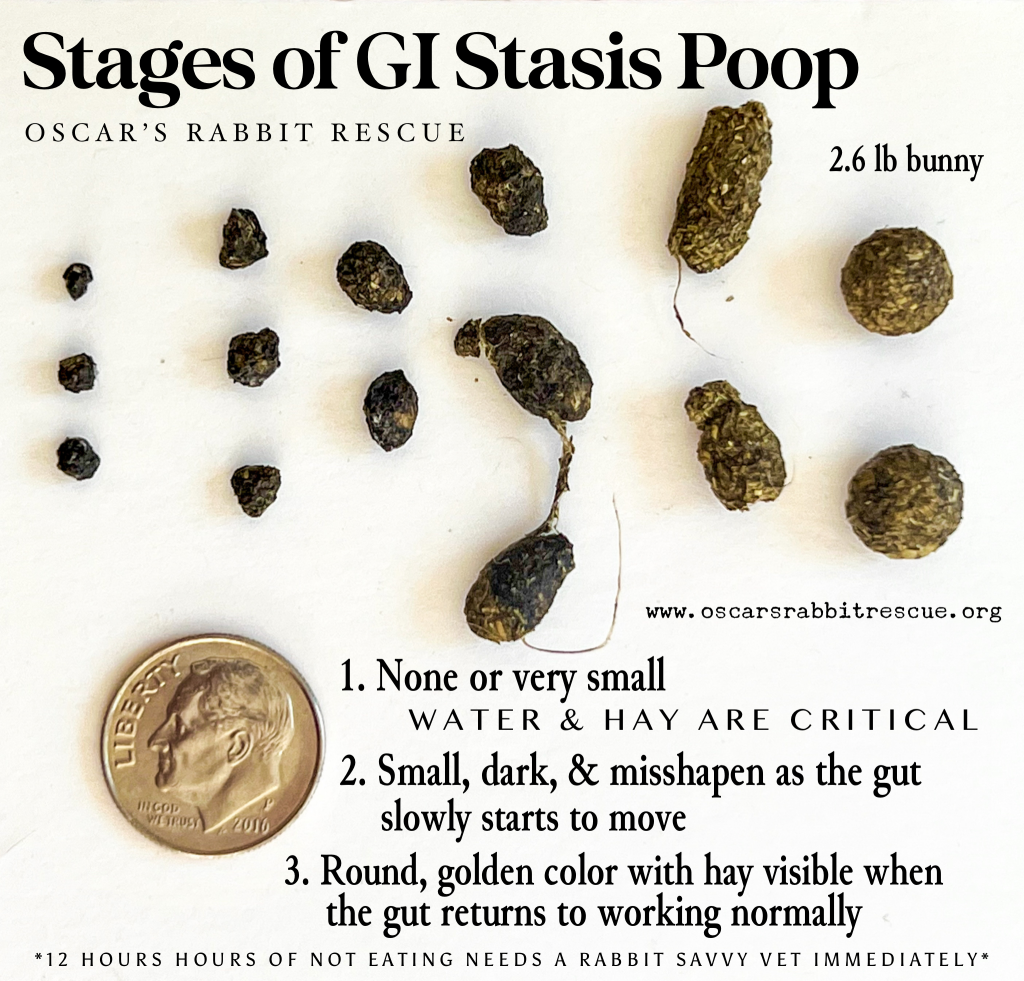Gastrointestinal (GI) stasis is one of the most important things to know about when owning a rabbit. It takes so many lives and fast, as quick as 24 hours.
If your rabbit stops eating or producing feces for 12 hours, you should consider this an EMERGENCY that needs a rabbit-savvy vet NOW. If not promptly treated, your rabbit will succumb to a painful death within the next 12-24 hours.
What is GI Stasis?
When eating stops, the GI tract immediately slows (or stops completely) and may cause any food in it to become dry and hard which causes it to get stuck (blockage) as the GI tract can no longer push food through it. This is what is known as GI stasis or an ileus.
Bad bacteria builds up and causes gas and extremely painful bloating. Some bacterias produce deadly toxins that can damage the liver – to the point of causes death. Fatty liver disease and gastric ulcers may quickly form from not eating. Pain and bloating will further decrease appetite and motivation to drink.
Prompt veterinary treatment is needed for these cases. Ruling out a blockage at a rabbit-savvy vet is important because giving critical care when there is a blockage can cause fatal outcomes.
What To Expect from a Vet Visit:
Rule out blockage with an x-ray. Subcutaneous fluids. Pain medications. Motility & appetite stimulant medications as applicable. Other testing as applicable based on exam and discussion.
Discuss possible causes — GI stasis is always the result of a cause.
Rule out blockage with an x-ray. Subcutaneous fluids. Pain medications. Motility & appetite stimulant medications as applicable. Other testing as applicable based on exam and discussion.
Discuss possible causes — GI stasis is always the result of a cause.
Prevention with proper diet and exercise is goal (high fiber, low sugar). However, some buns are still prone.
Signs & Symptoms
It is vital to know the signs that rabbits can show when they are unwell:
- Decreased poop or loose poop (not diarrhea – true diarrhea is an emergency). Liquid or mushy cecotropes can result from an imbalance of the normal bacterial and fungal flora of the cecum. You may or may not see mucus around the feces from inflammation.
- Eating less or refusing a favorite food.
- Signs of pain or discomfort (hunched posture, teeth grinding, behavior changes) – more information here. Rabbits hide pain well due to being a prey animal, so once signs are seen you are in trouble and need to act quickly.
Why?
Possible Causes:
GI stasis is always a result of a cause. It is important to determine what caused it.
GI stasis is always a result of a cause. It is important to determine what caused it.
- Diet too low in crude fiber and/or too high in sugar/carbohydrates (wrong foods and/or too many treats are common causes)
- Stress
- Dehydration
- Illness/pain
- Intestinal blockage
- Medications
- Dental/teeth issues
Quick Actions Needed:
Treatment:
Hydration and pain relief are critical. Poops should eventually return to normal, round poops when the GI tract is hydrated and returns to working well with good motility. This takes time and patience, including hydrating and feeding throughout night-time hours.
- Abdominal massage. Gentle abdominal massage is one of the most effective ways to stimulate a lazy gut and help relieve gas. Video showing how to do this this: HERE.
- Simethicone 20 mg/mL (baby gas drops), dye and flavor free, may acutely help relieve gas pain. Give 1-2 mL every hour for 3 doses, then give 1 mL every 3-8 hours. Simethicone is safe to give, even as a precaution.
- Monitor temperature carefully with a rectal thermometer (normal temp. 101-103°F). A temp under 100°F is an extreme emergency. Get your rabbit to a rabbit-savvy vet immediately, taking a warm water bottle wrapped in a towel with your rabbit. See more information HERE.
- Fluids are very important to hydrate a potentially hard mass that has formed and stuck. ***Avoid any fluids with sugar.*** Water is ideal, but unflavored Pedialyte made for children may also be used.
- Force feeding with watered down Critical Care to encourage eating if a blockage has been ruled out. If you don’t have any, soften pellets with warm water (not too hot or it will destroy nutrients). Give 1-2 cc at a time in the cheek, allowing to chew and swallow. Aspiration is life threatening. Continue providing unlimited Timothy hay.
*If there is a blockage, force feeding can cause worsening and death. - Fresh, wet, leafy herbs. Entice your rabbit to eat with fragrant herbs (cilantro, parsley, mint, basil, dill, etc.). The water content and fiber will help.
- Lactobacillus acidophilus has been known to help. Only use non-dairy powder; no yogurt.
- Rabbit-savvy vet. Rule out blockage with an x-ray. Subcutaneous fluids. Pain medications. Motility medications. Appetite stimulant medications.
- See more HERE.
PREVENTION IS THE MOST IMPORTANT
Sources:
1. Kremples, D. (2013, February 10). Gastrointestinal Stasis: The Silent Killer. House Rabbit Society. https://rabbit.org/2013/02/gastrointestinal-stasis-the-silent-killer/.
2. Richardson, D. (2016, September 2). The veterinary nurse’s role in recognition and management of pain in rabbits. UK Vet: The Veterinary Nurse. https://www.theveterinarynurse.com/review/article/the-veterinary-nurse-s-role-in-recognition-and-management-of-pain-in-rabbits.
Education/Resources:
- ~Bringing Home a Pet Rabbit~
- ***Diet for a Domestic Rabbit
- Activities
- Ages & Stages of Life
- Baby Bunnies
- Bonding Rabbits
- Emergency Preparedness
- Ear Cleaning
- Enrichment Activities
- GI Stasis in Rabbits
- Grooming & Nail Trimming
- Household Hazards
- Litter & Litter Boxes
- RHDV-2
- Spay & Neuter
- Supplies
- Vets for Your Rabbit
- Wild Bunnies
- Bearded Dragons
- Guinea Pig Guide
- Blog

